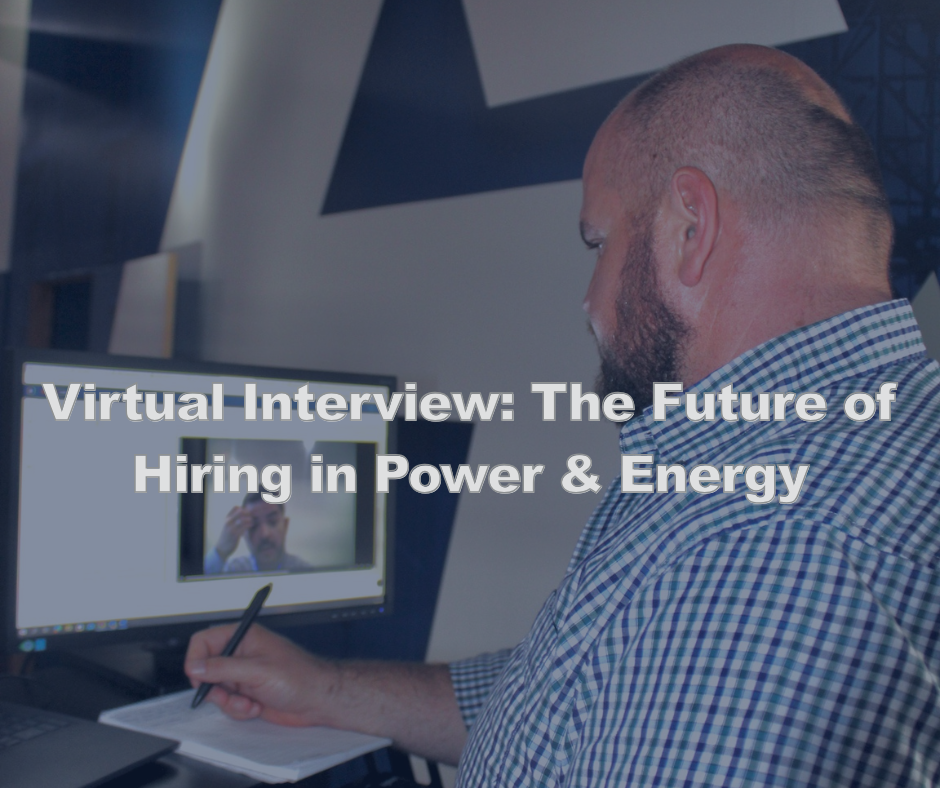
The energy sector is undergoing a significant transformation in 2025, propelled by the global shift towards cleaner energy sources, the rise of increased peaking power demands, rapid technological advancements, and continuously evolving workforce dynamics. As a result, energy providers and organizations within the energy sector face unique and complex challenges. They must adapt to these changes while simultaneously maintaining a skilled, qualified, and diverse workforce. This blog will explore the key workforce trends that are shaping the power and energy industry in 2025 and offer practical solutions that companies can implement to address these challenges effectively.
Key Trends Shaping the 2025 Energy Workforce
Several key trends are defining the energy workforce landscape in 2025:
Rapid Job Growth in Clean Energy: The clean energy sector is experiencing explosive job growth, expanding at more than double the rate of the overall economy. Clean energy jobs are increasing at a rate of 4.9%, compared to just 2.0% in other sectors. Renewable energy is a significant driver of this growth, with employment estimated to expand by 9% in 2025.
Increasing Demand for Skilled Workers: The energy industry faces a widening skills gap, particularly in high-growth areas such as solar, wind, and biofuels technologies. Projections estimate a global shortage of 7 million skilled workers for climate and energy projects by 2030, highlighting the urgent need to address this gap.
Rising Unionization Rates: Unionization is becoming more prevalent in the clean energy sector. For the first time, unionization rates in clean energy (12.4%) have surpassed the energy sector average (11%). Notably, unionized employers are reporting less difficulty in hiring compared to their non-union counterparts, suggesting a potential advantage in attracting talent.
Demographic Shifts: The energy workforce is becoming younger and more diverse. Workers under the age of 30 now represent 29% of the workforce. Additionally, Latino and Hispanic workers are filling a significant proportion of new energy jobs, accounting for nearly one-third of new positions in 2023.
Competitive Salaries: New clean energy subsidies, introduced as part of the Inflation Reduction Act, are driving salary increases in the renewables sector. Organizations are offering more competitive pay packages to attract and retain top talent amidst the growing skills gap.
Focus on Workforce Development: Utilities and renewable energy companies are actively implementing workforce development programs to strengthen, diversify, and upskill their talent pipelines. These programs often involve strategic partnerships with unions, educational institutions, and trade schools to ensure a well-prepared workforce.
The Changing Landscape of the Energy Workforce:
The energy sector is not only growing but also fundamentally changing, leading to evolving skill requirements and a shifting job market.
Shifting Skill Requirements: As the energy sector continues to evolve, the skills required to support it are also changing rapidly. The transition to renewable energy sources and the increasing integration of digital technologies are creating new demands for specialized expertise. Looking at 2025, projections indicate that as many as 50% of all white- and blue-collar employees will need re-skilling to adapt to increasing automation and technological adoption across industries. This shift is especially pronounced in the power generation sector, where traditional roles are being redefined, and entirely new positions are emerging.
Growing Talent Gap: The power generation industry is grappling with a significant and growing talent shortage. Projections suggest that up to 2 million manufacturing jobs could remain unfilled in 2025 if up-skilling and re-skilling efforts do not increase substantially to meet demand. This gap is further exacerbated by an aging workforce and the accelerating pace of technological change, creating a pressing need for effective workforce solutions.
Rise of Renewable Energy Jobs: The renewable energy sector is experiencing substantial growth in employment opportunities. Solar energy accounts for two-thirds of all renewable energy jobs, while wind energy accounts for a fifth. This trend is reshaping the job market within the broader energy sector, with hiring in renewables growing to twice the level of hiring in fossil fuels.
Increasing Demand for Green Skills: The utility industry, which has the greatest share and demand for green skills, is facing stiff competition for talent from the technology industry and other infrastructure-building sectors. This competition is driving the need for innovative workforce solutions that can effectively attract and retain skilled professionals in the energy sector.
Key Workforce Trends in 2025:
Several workforce trends are particularly prominent in 2025:
- Emphasis on Up-skilling and Re-skilling: Power providers are recognizing the critical importance of up-skilling and re-skilling their existing workforce to meet evolving industry needs. In 2025, a significant increase in investment in training programs is expected. These programs will focus on developing new competencies in areas such as renewable energy technologies, digital systems, and advanced power plant operations.
- Integration of Contract Workers: The use of contingent workers is on the rise, with 84% of companies utilizing temporary labor to address worker shortages and volatile market demands. This trend is expected to continue throughout 2025, providing energy generation companies with greater flexibility in managing their workforce and accessing specialized skills.
- Focus on Digital Skills: As power plants become increasingly digitized, there is a growing demand for workers with expertise in areas such as data analytics, artificial intelligence, and cybersecurity. In 2025, these digital skills will be essential for many roles within the power generation sector.
- Growth in Clean Energy Jobs: The transition to clean energy is creating new job opportunities across the power sector. By 2050, the nuclear sector alone is projected to create between 74,000 and 223,000 permanent jobs in operations and maintenance. This trend highlights the need for workforce solutions that can support the continued growth of clean energy technologies.
Workforce Solutions for Power Producers:
To navigate these challenges and capitalize on the opportunities presented by the evolving energy landscape, power plant companies should consider the following workforce solutions:
Develop Comprehensive Training Programs: To address the skills gap and prepare for future needs, power plant companies should invest in robust training and development programs.
- Technical skills related to new technologies
- Essential digital competencies such as data analysis and cybersecurity
- Critical soft skills, including adaptability and problem-solving
Implementing a mix of in-house training, strategic partnerships with educational institutions, and online learning platforms can provide employees with diverse and accessible learning opportunities.
Implement Flexible Staffing Models: Implementing flexible staffing models is a key component of these solutions, enabling companies to effectively manage fluctuations in demand and access specialized skills on demand.
- Utilizing a mix of full-time, part-time, and temporary workers
- Implementing innovative job-sharing programs
- Offering remote work options where feasible
By embracing these flexible models, companies can better align their workforce with changing business needs while also attracting a wider and more diverse pool of talent.
Foster a Culture of Continuous Learning: Creating a company culture that values and encourages continuous learning is crucial for staying ahead in the rapidly evolving energy sector.
- Establish mentorship programs to facilitate knowledge transfer and skill development
- Provide opportunities for cross-functional training and strategic job rotations
- Recognize and reward employees who actively pursue skill development and growth
This approach yields multiple benefits, including addressing critical skill gaps and significantly improving employee engagement and retention rates.
Implement Workforce Solutions that Leverage Advanced Technology: Utilizing advanced workforce management technologies can help energy providers optimize their human resources.
- Implementing AI-powered scheduling systems to improve workforce efficiency and reduce administrative burden
- Using data analytics to predict future skill needs and inform strategic hiring decisions
- Adopting virtual reality training simulations for safe and cost-effective skill development
These technological solutions can enhance overall workforce productivity and effectiveness, driving significant improvements in operational performance.
Leverage a Staffing Company for Your Manpower Needs: Partnering with a specialized staffing company like APS Solutions can provide invaluable support in navigating the evolving power and energy sector.
- APS offers comprehensive workforce solutions tailored to your specific needs. As the energy landscape continues to transform, APS provides a range of services to address the challenges faced by companies in this dynamic industry.
- APS provides specialized expertise in energy, process plant, and heavy industrial staffing, focusing on building strong long-term relationships with clients and employees. Our industry-specific knowledge allows us to understand the unique staffing requirements of power and energy companies.
- Our comprehensive workforce solutions can help you proactively manage your company’s positions, accurately forecast future hiring needs, and effectively budget for talent acquisition. This is particularly valuable in the rapidly changing energy sector, where having the right talent in place is crucial for success.
Power Up Your Projects with APS Solutions:
Flexible Staffing Models: APS Solutions offers flexible staffing options to help you adapt to changing market demands.
- Contract staffing for short-term projects or peak periods.
- Contract-to-hire opportunities to evaluate potential long-term employees.
- Direct hire services for permanent positions.
Skilled Workforce Provision: APS delivers qualified, dedicated, and skilled workers who can get the job done right.
- Experienced professionals in various energy-related fields.
- Specialists with up-to-date knowledge of industry trends and technologies.
Up-skilling and Re-skilling Support: To address the growing need for a highly-skilled workforce.
- Identifying skill gaps in your project.
- Providing workers who are already trained in emerging technologies and practices.
Industry-Specific Expertise: With a focus on the power and energy sector.
- Deep understanding of industry-specific challenges and requirements.
- Access to a network of professionals with relevant experience and qualifications
Safety and Compliance: APS Solutions safety is our top priority. Here at APS we put safety first that why we are well versed in:
- The latest safety protocols and regulations.
- Environmental compliance requirements.
- Risk management strategies specific to the energy sector.
By leveraging APS Solutions’ workforce solutions expertise, companies can create a workforce that is not only skilled in current technologies but also prepared for future challenges in the energy market. This partnership can lead to improved operational efficiency, increased innovation, and a stronger competitive position in the rapidly evolving energy landscape.






